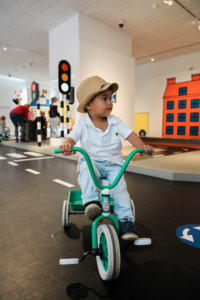This guest blog comes from Rina Mae Acosta, co-author with Michele Hutchison of The Happiest Kids in the World. Rina Mae Acosta is a writer from California currently living in the Netherlands with her Dutch husband and two young sons. She founded the successful parenting blog Finding Dutchland.
Dick Bruna, Miffy and I
Father’s day is around the corner, and I can’t help but think of the unofficial Opa (grandfather) of the Netherlands: Dick Bruna. With nothing more than a blank piece of paper, a pencil, and a desire to entertain his young son during a rainy, seaside holiday, Bruna created Miffy, known as Nijntje (pronounced nein-che, “little rabbit”) in Holland. With his signature gray hair and mustache, round glasses, and soft-hearted nature, Bruna reminded me of a real-world version of Mister Gepetto from “The Adventures of Pinocchio.” As Gepetto-incarnate, ever so humble and kind, Bruna’s brought so much happiness to everyone who stumbled upon his work.
Bruna had an innate understanding of the world of children, creating characters, settings and rhyming storylines that were as simple as possible. Like a wise, kind grandfather figure, Bruna celebrated what we as adults often take for granted and consider insignificant minutiae of life but are held dear to small children – getting ready for bed, preparing breakfast, celebrating a birthday, going to the beach, visiting the zoo, and riding a bike.
 For many Dutch children, the Miffy books are their first introduction to reading. Ina, the ten-year-old daughter of Michele Hutchison – the co-author of our recently published book, The Happiest Kids in the World – says, “my favorite book when I was little was Miffy at the Zoo. I like how the stories rhyme.” “The writer Dick Bruna died recently and that’s really sad,” she said, clearly still remembering the sense of loss that was felt across the nation, and reverberated around the world. My husband Bram often reads the Miffy books to our two boys, and bedtime wouldn’t be complete without a stuffed Miffy doll in our almost two-year-old’s arms.
For many Dutch children, the Miffy books are their first introduction to reading. Ina, the ten-year-old daughter of Michele Hutchison – the co-author of our recently published book, The Happiest Kids in the World – says, “my favorite book when I was little was Miffy at the Zoo. I like how the stories rhyme.” “The writer Dick Bruna died recently and that’s really sad,” she said, clearly still remembering the sense of loss that was felt across the nation, and reverberated around the world. My husband Bram often reads the Miffy books to our two boys, and bedtime wouldn’t be complete without a stuffed Miffy doll in our almost two-year-old’s arms.

Bruna’s stories evoke nostalgia in parents, highlighting common, everyday experiences all children are familiar with. Getting lost in the world of Miffy and friends gives us the opportunity to re-realize that childhood (and life in general) is really all about the small, simple everyday pleasures. “I always loved the drawings; they are so simple and colorful. They made the books really special,” says Ina’s eleven-year-old friend Noor.
For children around the world, especially in Holland and in Japan, Miffy is very much alive. Her influence extends beyond the pages of the books she’s featured in. Miffy is everywhere young children can be found: nursery decorations, street signs warning drivers to slow down, schools, museums, parks, beaches, zoos, and airports. And for many Dutch children, childhood isn’t complete without the joy of Miffy. And as grown-ups, many Dutch people can still quote their favorite Miffy books off by heart.
It isn’t hard to imagine Bruna as an honorary grandfather figure in his home country, especially in Utrecht where he was born and where he lived most of his life. Despite being a world-renowned artist who sold over 85 million copies of 100-odd Miffy books, Bruna remained an unassuming familiar fixture at a local neighborhood café in Utrecht for decades, greeting fans and familiar faces. He would also randomly appear, unannounced to the delight of children and parents, to Miffy-related performances and events. Bruna knew the secret to living a life well lived, having once been quoted, “For me, happiness is cycling to my studio very early in the morning.”



